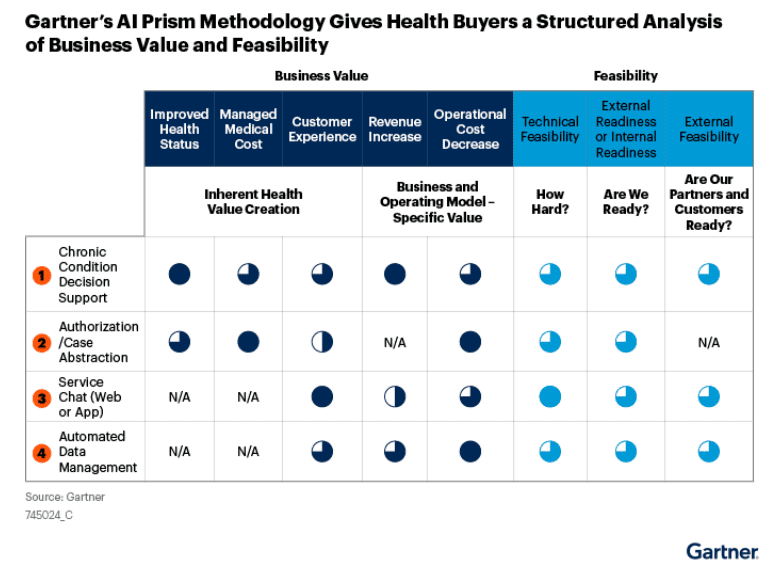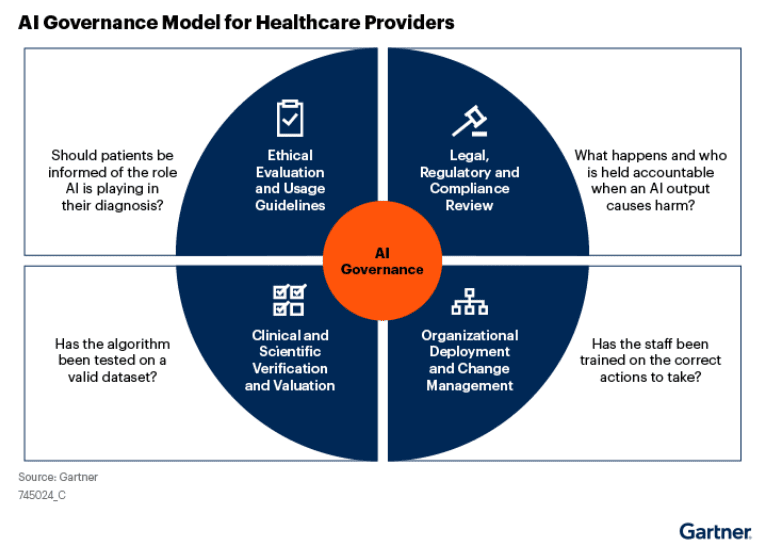In the last five years, healthcare providers have rapidly implemented artificial intelligence (AI) into business and technology strategy planning. However, as these organizations strive to move from strategy to execution, they often encounter numerous gaps in healthcare that pose significant challenges.
This article will dive into 3 requirement gaps that healthcare providers encounter and how they can overcome them to enhance patient outcomes in the digital healthcare landscape.
3 Requirement Gaps from Plan to Practice

As healthcare organizations shift their focus to AI adoption, three key gaps have come up between implementing companies’ requirements and suppliers’ current products and services:
#1 Demonstrable business and clinical outcomes
One of the major challenges in healthcare AI is the gap between the potential promised by AI technologies and the actual business and clinical outcomes. While there is great excitement about the transformative power of AI in healthcare, there is often a lack of concrete evidence showing the real-world impact and benefits. It is crucial to bridge this gap by conducting rigorous research and evaluation studies to validate AI solutions’ effectiveness, safety, and cost-effectiveness.
#2 Governance and Ethics Practices:
As AI technologies become more prevalent in healthcare settings, it is essential to establish robust governance frameworks and ethical guidelines to guide their development and use. This includes addressing privacy, security, data sharing, bias, and transparency issues. AI’s responsible and ethical use in healthcare requires clear data privacy and consent guidelines, algorithmic transparency, and accountability in decision-making.
#3 Digital Transformation Services:
Implementing AI technologies in healthcare organizations often requires significant changes in workflows, infrastructure, and skill sets. Many healthcare providers face challenges in integrating AI solutions seamlessly into their existing systems and processes. Bridging this gap involves assessing current IT infrastructure, identifying gaps, providing training and support to healthcare professionals, and ensuring interoperability and data integration across different systems.
Close the Gaps for Better Patient Care
#1 Demonstrate how AI adds value to your product or service
Healthcare buyers are concerned that the value you promote with your product or service will be fulfilled. The more effectively you demonstrate that AI generates genuine economic value, the more likely you will win the deal. Gartner’s AI prism methodology has proven to be an effective tool for healthcare buyers in this area.

This methodology helps organizations in the healthcare industry evaluate the potential benefits and challenges associated with adopting AI technologies.
- Business Value Assessment:
The AI Prism methodology begins with a comprehensive assessment of the potential business value that AI can bring to healthcare organizations. This involves identifying specific use cases where AI can make a meaningful impact, such as improving diagnosis accuracy, streamlining administrative processes, or enhancing patient outcomes.
- Feasibility Analysis:
After identifying the potential use cases, the AI Prism methodology focuses on assessing the feasibility of implementing AI solutions. This includes evaluating technical aspects, such as data availability, quality, and compatibility with existing systems. Organizational readiness is also considered, including the skills and capabilities required for successful AI implementation.
- Risk Assessment:
This methodology recognizes the importance of considering the risks associated with AI implementation in the healthcare industry. The AI Prism methodology provides a structured approach to identifying and assessing data privacy, security, bias, and regulatory compliance risks.
- Value Realization Planning:
This step involves developing a roadmap that outlines the necessary steps for successful AI deployment, including data acquisition, model development, integration with existing systems, and change management. Gartner assists health buyers in creating a practical and actionable plan that aligns with their specific organizational goals, timelines, and resource constraints.
#2 Support the buyer in overcoming the complex nature of AI and cultural obstacles to AI adoption
Throughout Gartner studies carried out between 2018 and 2020, healthcare providers consistently ranked algorithmic bias, data privacy, and security as top barriers to AI implementation. For example, 38% of healthcare provider participants indicate they are eager to look into using AI, but they need to understand the structure and impact of the AI algorithm before using it.
These providers want to know if the data used to train an AI model is close to the patient group. They are concerned about the lack of transparency into how algorithms get trained to work in healthcare, which gets worse by the built-in systemic prejudice in many AI apps and training datasets. These worries worsen for brand-conscious healthcare businesses whenever the press reveals alarming impacts of the algorithms expanding use in healthcare decision-making.
These findings indicate a strong need for “explainable AI” — AI technologies that all stakeholders easily understand. Many companies have taken the first steps toward explainable AI by making their AI algorithms’ general features accessible and reviewable to anyone. However, it is far more crucial to help the healthcare buyer comprehend the decision process: how an algorithm generates a proposal and how an AI model supports decisions that affect patients.

To establish effective AI governance, 4 key pillars need to be considered.
- Ethical Evaluation and Usage Guidelines:
This pillar focuses on the ethical considerations and guidelines for AI systems. It addresses questions such as: Should patients be informed of AI’s role in their diagnosis? Transparency and informed consent are crucial in building trust with users of AI systems. Guidelines should be established to ensure that AI applications are developed and used in a manner that respects individual rights, privacy, fairness, and accountability.
- Legal, Regulatory, and Compliance Review:
This pillar involves determining the laws and regulations that apply to AI systems and ensuring compliance with them. Questions include: What happens, and who is held accountable when an AI output causes harm? need to be addressed. Clear guidelines should be established to assign responsibility and liability in cases AI systems cause harm or operate in violation of legal or regulatory requirements.
- Clinical and Scientific Verification and Valuation:
Rigorous testing and evaluation protocols should be in place to ensure AI systems’ accuracy, reliability, and safety. Questions such as: Has the algorithm been tested on a validated dataset? are crucial to ensure that the AI system meets appropriate scientific and clinical standards before deployment.
- Organizational Deployment and Change Management:
This pillar deals with questions about deploying, integrating, and managing AI systems within organizations. Adequate training and education programs should be provided to the staff to ensure they are equipped with the necessary skills and knowledge to understand AI systems and take appropriate actions. Questions such as: Has the staff been trained on the correct actions to take? are important to ensure smooth integration and effective use of AI technologies within the organization.
#3 Support Buyers’ Value Realization Goals With Transformation Services

As a product leader, you must keep ongoing discussions with your customers about how their AI projects will be completed and the responsibilities you and they will play. You must specify who will be in charge of implementation and management, as well as how companies will work together, who should be on the team, and what the end result should be for the client.
However, for an enterprise healthcare buyer, leveraging the benefit of cutting-edge technologies such as AI often requires acquiring new and unfamiliar talents, skills, and resources. Basic data literacy, ethical use standards, AI engineering, and AI governance structure are common competencies for solutions that enable enterprises to design and manage AI models.
Therefore, transformation services sometimes involve process reengineering skills for products with more deeply embedded AI. Some healthcare businesses, for example, are embedding AI-enabled chatbots in their customer contact centers to operate with human employees. The chatbot may be set up to perform simple, routine activities but will transfer to a human agent when necessary. Customers want mock scenario training help in order for the handoff to be seamless to the end users.
Paving the Way for Healthcare AI
As more health organizations begin to ride the AI wave, businesses may find it difficult to navigate the complex landscape of AI deployment. This is when the benefits of AI roadmap consultation come into play.
Businesses may get the full benefits of AI while avoiding typical mistakes and positioning themselves for future success by working with the right qualified advisors. An AI roadmap consultant like CMC Global may help assess readiness, provide technological suggestions, handle risks, and ensure effective AI adoption. Contact us for further consultation.




